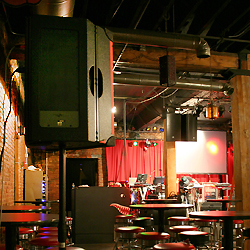
Stands & Poles. While usually safe, tripod stand legs should be extended to their largest footprint when possible to provide maximum stability. Also, position the legs so they won’t present a trip hazard, something that can both cause an injury as well as, as possibly knock over the stand and loudspeaker.
Use fixed leg tripod stands only on level ground. Saddle-style sandbags can be used with tripod stands to add a bit of weight to the bottom for increased stability. The sandbags should straddle the leg, not hang from any bracing.
In addition, the top of the stand should be correctly sized for the socket or the loudspeaker can tilt, with its center of gravity no longer directly above the stand pole and thus creating an unbalanced situation. To avoid crew injury, larger loudspeakers should be hoisted onto stands by two people.
Tripod stands provide a quick and easy way to get smaller loudspeakers in the air. However, be careful not to overload them. Some full-range loudspeakers offer two angle positions on their stand sockets, allow tilting as well as raising them higher. Make sure the stand is stable before tilting.
A loudspeaker on a mounting bracket can be positioned on the tripod and adjusted as needed to cover the crown. Third-party units are also available to tilt loudspeakers while keeping their center of gravity over the pole.
Pole mounting a loudspeaker on a subwoofer provides a clean and easy setup for many gigs. It allows the top cabinet to be raised to a reasonably good operating height while eliminating the tripod base that may become a trip hazard. Some packages allow for the use of two poles for larger top cabinets or line array-style boxes. To avoid problems, use only the manufacturer’s recommended poles with these systems, as different poles may not be compatible or as stable as the factory units.
Crank Towers. These come in many forms, ranging from larger versions of tripods to heavy-duty units that can hold 600-plus pounds. They’re becoming a popular option to fly smaller arrays without motors. All outriggers and legs should be extended and the tower leveled correctly before raising a load. Also factor in the rigging hardware weight and loudspeaker cable weight when calculating the total weight to be lifted. Check with the manufacturer before using the lift outdoors, and always follow their recommendations.
Pair Of Towers & Truss. This is a common approach for medium-sized shows and corporate events, utilizing two crank towers and a span of truss that usually runs above the front of the stage. The truss usually does double duty in supporting front stage wash lights as well as loudspeakers. It can also provide the ability to deploy compact arrays left, center and right (LCR) without requiring any ceiling points.
Care should be taken to not overload, because the total working load of the entire system on horizontal truss is based on an evenly distributed load. Also take into consideration the weight of the truss, loudspeakers, lights and lighting cables when figuring out the total weight of the system on the crank towers. This type of setup is considered a rigging system and needs to be designed by a qualified rigger.

Line Array Tower Truss. A relatively new option for positioning loudspeakers is the line array tower. Made from truss sections and specialty hardware fittings, they can be disassembled for transport or storage and easily bolted together on the job site to support a wide variety of arrays. When used outdoors make sure the unit is guyed down per the manufacturer’s recommendations. Some models allow subwoofers to be placed on the forward outrigger legs where they can be used as additional ballast while operating.
Dead Hang. This means that an item is connected to a support structure without a motor or lift system. The attachment point can be an exposed ceiling beam, tent pole, section of truss, etc. An engineer should be called in to certify the weight loading ability of any ceiling point before use if it’s not known. Only competent or qualified riggers should dead hang cabinets because each hanging point needs to be individually assessed by a person with knowledge and experience to determine what hardware is required to safely support and position the loudspeakers.
Motor Hang. Only competent riggers should install and operate motor systems. All flyware should be checked prior to use. An engineer should certify all attached rigging points before hanging any motors.
Regardless of what’s being used to position loudspeakers off the ground, check all rigging equipment on a regular basis, including stands, and don’t hesitate to pull damaged or questionable items from service. Also perform preventative maintenance, such as lubrication, as recommended by manufacturers. Finally, never use damaged or questionable rigging hardware, stands or fittings.
Senior contributing editor Craig Leerman is the owner of Tech Works, a production company based in Las Vegas.
